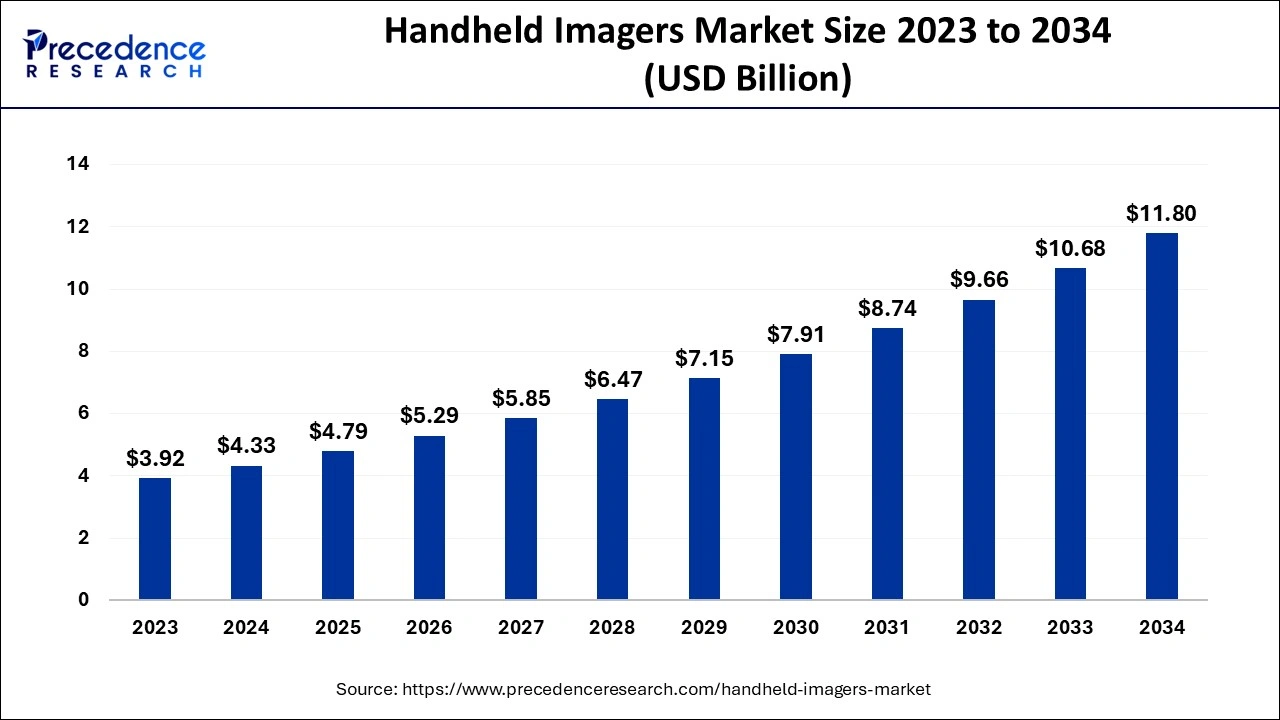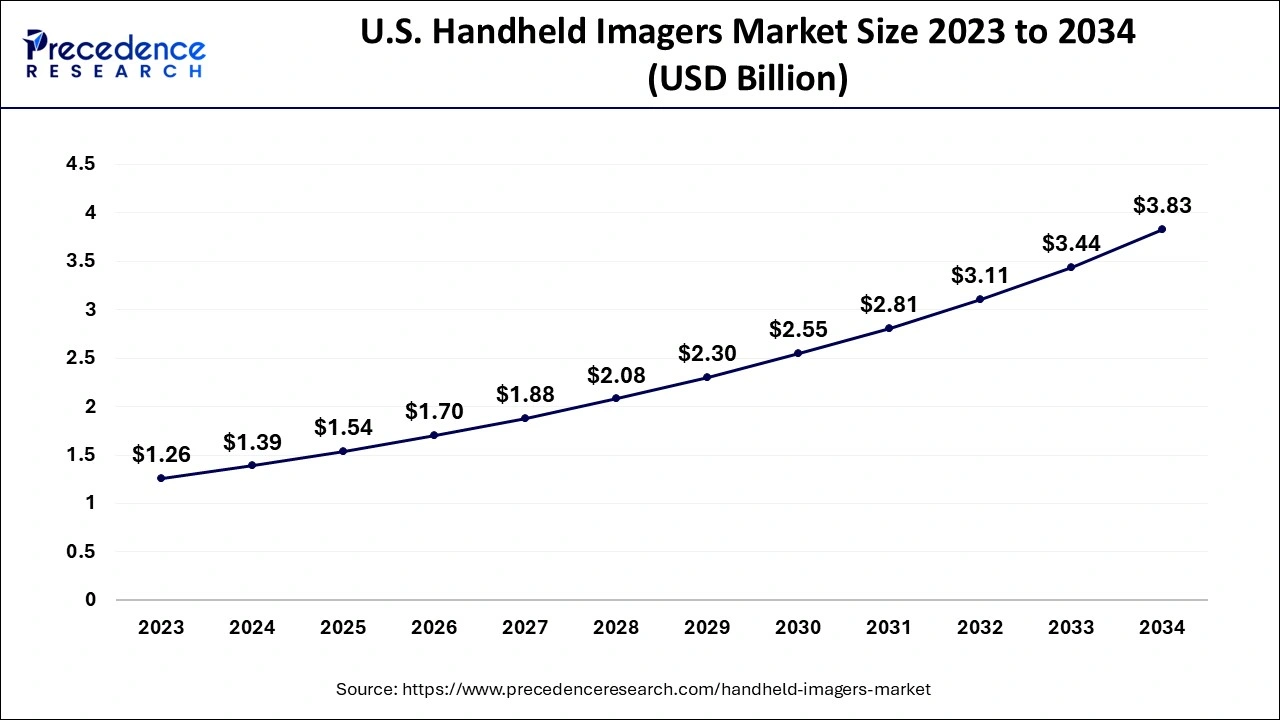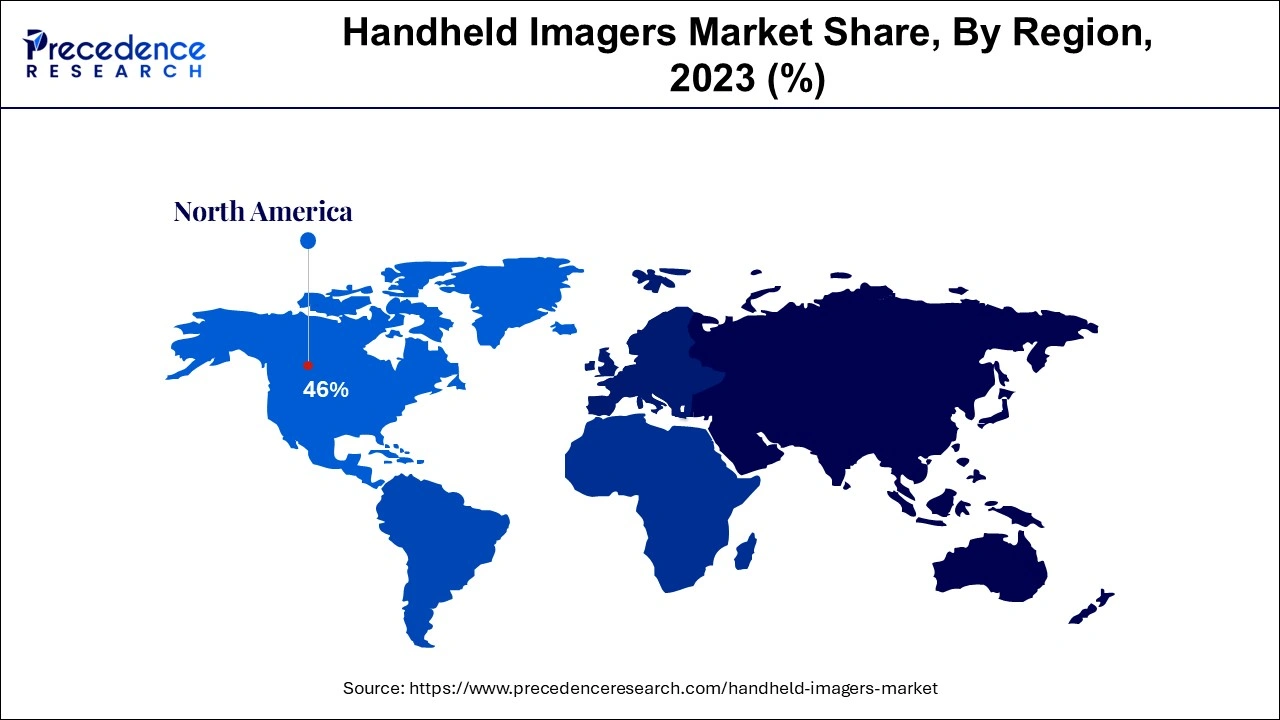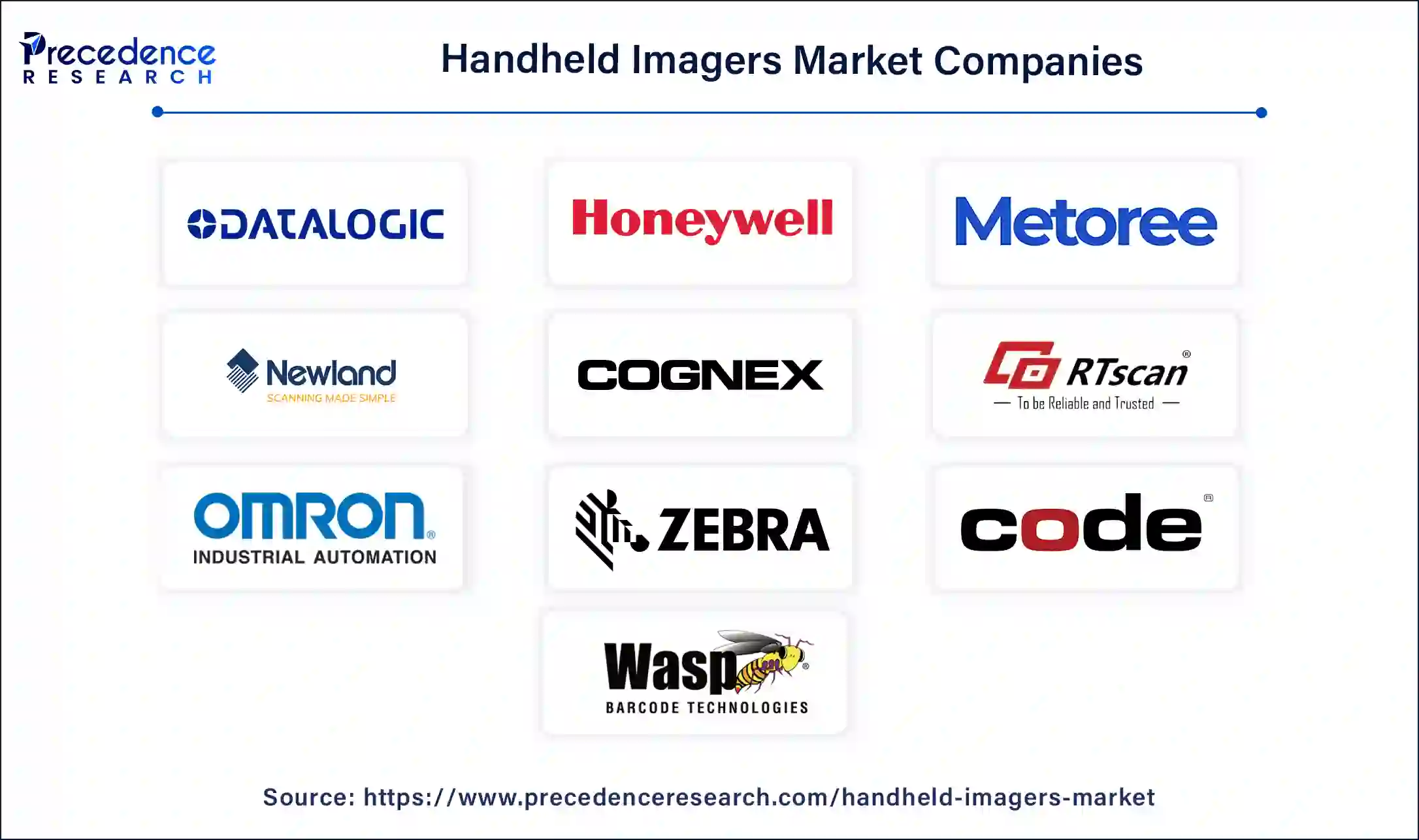The global handheld imagers market size calculated at USD 4.33 billion in 2024, grew to USD 4.79 billion in 2025 and is expected to be worth around USD 11.80 billion by 2034, registering a CAGR of 10.54% between 2024 and 2034. The North America handheld imagers market size is evaluated at USD 1.99 billion in 2024 and is expected to grow at a CAGR of 10.56% during the forecast year.
The global handheld imagers market size accounted for USD 4.33 billion in 2024 and is expected to exceed around USD 11.80 billion by 2034, growing at a CAGR of 10.54% from 2024 to 2034. The rising demand for the handheld imagers market is due to the ability to convert physical documents into digital forms to store, edit, transfer, and email digitally.

The integration of artificial intelligence (AI) in the handheld imagers market is revolutionizing the barcode scanning technology. AI introduces an advanced level of efficiency, automation, error reduction, and predictive maintenance in industries such as retail, logistics, healthcare, and manufacturing. The most significant improvement was noticed in the ability to read damaged or incomplete barcodes. AI-powered systems analyze patterns, intelligently predict missing or damaged portions, and fill out the gaps.
The U.S. handheld imagers market size is exhibited at USD 1.39 billion in 2024 and is projected to be worth around USD 3.83 billion by 2034, growing at a CAGR of 10.64% from 2024 to 2034.

North America dominated the global handheld imagers market with the largest market share in 2023. The dominance of the segment is noted due to its portability, flexibility, and convenience, which ensures users caption 3D data with precision and efficiency. In the North American region, the rising industrial demand for on-site data capture and real-time analysis, such as architecture, engineering, and construction, is propelling the growth of the market. Additionally, North America is home to major retailers such as Walmart and Amazon.

Asia Pacific is observed to witness notable growth in the handheld imagers market during the forecast period. The growth of this market in the region is noticed due to diverse applications across various industries. The main industries of utilization include automation, healthcare, manufacturing, and consumer electronics. The increasing trend of automation, sustainability initiatives, and advanced technology is reshaping the market, resulting in enhanced product offers via key players. Additionally, the growing demand for efficiency and performance.
A handheld imager is a portable device used to interpret barcodes, digitized images, and text from physical documents or objects. It converts the physical information into digital format, which makes it easier to access, edit, and share. It is equipped with sensors and optical components that translate the barcode into a readable format; it can also be stored, processed, or transmitted through a computer or other digital devices. They are usually battery-powered devices, able to scan both 1D and 2D digitalized images.
Handheld imagers are available in various shapes and sizes, such as gun-style, wand-style, and pocket size. The application of handheld scanners is commonly witnessed in the retail and logistics industries, as they scan data from barcodes on products, packages, and shipping labels. Another application is in healthcare facilities, where it tracks medical equipment and supplies. Additionally, it is useful in scanning mobile tickets and event passes for quick and efficient entry to the movies or concerts.
| Report Coverage | Details |
| Market Size by 2034 | USD 11.80 Billion |
| Market Size in 2024 | USD 4.33 Billion |
| Market Size in 2025 | USD 4.79 Billion |
| Market Growth Rate from 2024 to 2034 | CAGR of 10.54% |
| Largest Market | North America |
| Base Year | 2023 |
| Forecast Period | 2024 to 2034 |
| Segments Covered | Product, Application, and Regions |
| Regions Covered | North America, Europe, Asia-Pacific, Latin America and Middle East, and Africa |
Technological advancements
The handheld imagers market is projected to grow due to technological advancements and innovations. Innovations noticed in recent times are the integration of high-resolution sensors, improved image processing algorithms, and enhanced thermal imaging capabilities, which have significant applications in various industries. Technological advancements reduce the cost of manufacturing and give access to a broader range of users. The new features, such as wireless connectivity, cloud-based data storage, and real-time analytics.
QR code phishing
QR code phishing is a rapidly evolving threat that attacks using QR codes to trick victims into revealing sensitive information or installing malware. Scammers use QR codes in emails, text messages, social media, and public places or approach directly. To avoid such attacks from happening, install a multi-layered detection that will provide robust, real-time protection against phishing attacks of all types, focusing on the need for advanced security solutions to deal with evolving threats.
Augmented reality in handheld imager
Augmented reality is a futuristic concept that can be witnessed in the handheld imagers market. Initially, this concept will be introduced in the construction industry, utilizing a handheld scanner to create a 3D model of a building site, resulting in improving project planning and reducing material waste. Additionally, this incorporation will speed up the project's pace and minimize costly errors.
The stud finders segment contributed the highest share of the handheld imagers market in 2023. The stud finder is a device used to pinpoint metal studs, nails, and screws embedded within wood buildings to locate framing studs behind the final walling. There are two main categories of stud finders: magnetic and electric. The magnetic stud finders use a magnet to locate the metal in the walling material. An electronic stud finder uses sensors to detect changes in the dielectric constant on the wall. The sensor fluctuates on the detection of the stud, displaying a lower reading.
The IR scanners segment is predicted to witness significant growth in the handheld imagers market over the forecast period. The growth of this segment is observed due to the need to confirm machinery is working normally and to detect abnormal heat patterns within the machine, indicating inefficiency and defects. In humans, the infrared scanner is used to measure body temperature.
The security segment captured the biggest share of the handheld imagers market in 2023. The rising preference for handheld scanners at airports, courts, malls, prisons, and defense bases is increasing the demand for this segment in the market. The handheld scanner uses an electromagnetic field to detect the metallic object present over a person. Due to the affordability factor, the use of handheld metal detectors increases the number of places to improve security, such as nightclubs, outdoor music concerts, and sports stadiums. This device easily detects knives, weapons, drugs wrapped in foil, and other metallic objects.
The medical segment will witness significant growth in the handheld imagers market during the forecast period. The healthcare industry is constantly evolving, introducing new procedures, medicines, and regulations. The integration of a barcode scanner aids in improving the operational performance and accuracy of routine activities. The barcode technology helps professionals focus more on the patient and ensure safe and finest care. The barcode technology in healthcare offers surgical instrument identification and patient identification, ensures accurate specimen collection, reduces the risk of blood transfusing errors, and helps in tracking inventory.

By Product
By Application
By Geography
For inquiries regarding discounts, bulk purchases, or customization requests, please contact us at sales@precedenceresearch.com
No cookie-cutter, only authentic analysis – take the 1st step to become a Precedence Research client